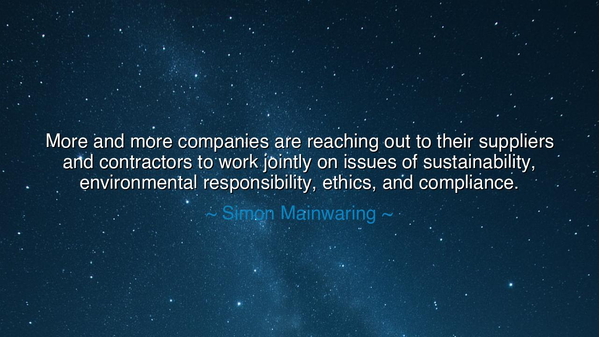
More and more companies are reaching out to their suppliers and
More and more companies are reaching out to their suppliers and contractors to work jointly on issues of sustainability, environmental responsibility, ethics, and compliance.






In the marketplaces of old, when caravans crossed deserts and ships stitched continents together, wise merchants knew that no fortune was made alone. Simon Mainwaring, speaking to our age, names this ancient truth in modern tongue: “More and more companies are reaching out to their suppliers and contractors to work jointly on issues of sustainability, environmental responsibility, ethics, and compliance.” Hear the drumbeat beneath his words: enduring prosperity is a covenant, not a raid; a chain is only as strong as its most distant link. When companies forget this, profit becomes a fever that burns the very house in which it sleeps. When they remember, trade becomes stewardship, and stewardship becomes legacy.
To work jointly is to renounce the illusion of solitary virtue. A single firm signing a pledge is like a lone lantern in a storm; a thousand lanterns strung along the road turn a perilous night into a navigable path. Suppliers draw raw strength from soil and sweat; contractors translate vision into brick, bolt, and code. If these hands are unclean, the finished work is stained, no matter how bright the showroom. Thus the call to sustainability and environmental responsibility cannot stop at the city gate of the brand. It must travel the river to the headwaters, asking: who harvested, who dyed, who soldered, who paid the hidden price?
Consider a story written in the memory of our times. After the Rana Plaza collapse in 2013, the world saw what happens when the vows of ethics and compliance are treated as decorations rather than foundations. In the grief that followed, brands, factories, unions, and inspectors forged a binding accord in Bangladesh—funding structural upgrades, publishing inspections, and tying orders to safer practices. This was not charity; it was accountability braided into commerce, a recognition that companies, suppliers, and contractors must work jointly or else fail together. From the ruins rose a sterner wisdom: safety is not a feature; it is the floor upon which all other features stand.
The earth, too, has kept her ledger. In forests thinned for quick gain, in rivers dulled by dyes, in skies bruised by smoke, the cost of ignoring environmental responsibility compounds like cursed interest. Yet when a firm collaborates upstream—requiring certified fiber, regenerative agriculture, low-impact chemistry, renewable power—small compliance steps multiply into great relief. The field breathes, the river clears, the worker’s lungs rest easier, and the product carries a story that does not shame its makers. This is the arithmetic of hope: shared standards, shared data, shared repair.
The elders would say: law guides, but culture guards. Policies of compliance are the walls; the living spirit of ethics is the watchman who stays awake. To build both, leaders must practice covenantal procurement: map the chain, reveal the risks, price the remedies, and bind the remedies to the contract. Teach your partners how to meet the mark; do not merely threaten them for missing it. Share tools, not only terms. In this way, companies sow trust along their routes, and trust returns as resilience in drought, strike, recall, or storm.
What lesson, then, shall we take to heart? That greatness in commerce is not the roar of quarterly triumphs but the quiet continuity of just relationships. Let your brand be a bridge, not a banner. Let your purchase order be a promise. Let sustainability be the first design constraint, not the last talking point. And remember: when you clasp hands across the chain, you do not divide your strength—you multiply it.
Practical steps for those who would walk this road: (1) Set a shared sustainability scorecard with your suppliers and contractors, tied to clear incentives and timelines. (2) Trace materials to their sources; publish the map so your ethics can be seen, not only declared. (3) Fund capacity-building—safety training, clean-process upgrades, fair-wage pilots—so compliance is achievable, not ceremonial. (4) Establish grievance channels that protect the smallest voice in the largest factory. (5) Review annually with independent audits, and when you fall short, confess in daylight and repair in earnest. Do these things, and your enterprise will stand like an oak by a river—rooted, shading many, drinking deep without draining the land.
Thus Mainwaring’s line returns to us like an old song remembered: trade well, together. Tie your fortune to the flourishing of those who toil beyond your sight. For in the long run of history, only those companies that work jointly in environmental responsibility, ethics, and compliance will hand their names to the future without a tremor in the voice.






AAdministratorAdministrator
Welcome, honored guests. Please leave a comment, we will respond soon